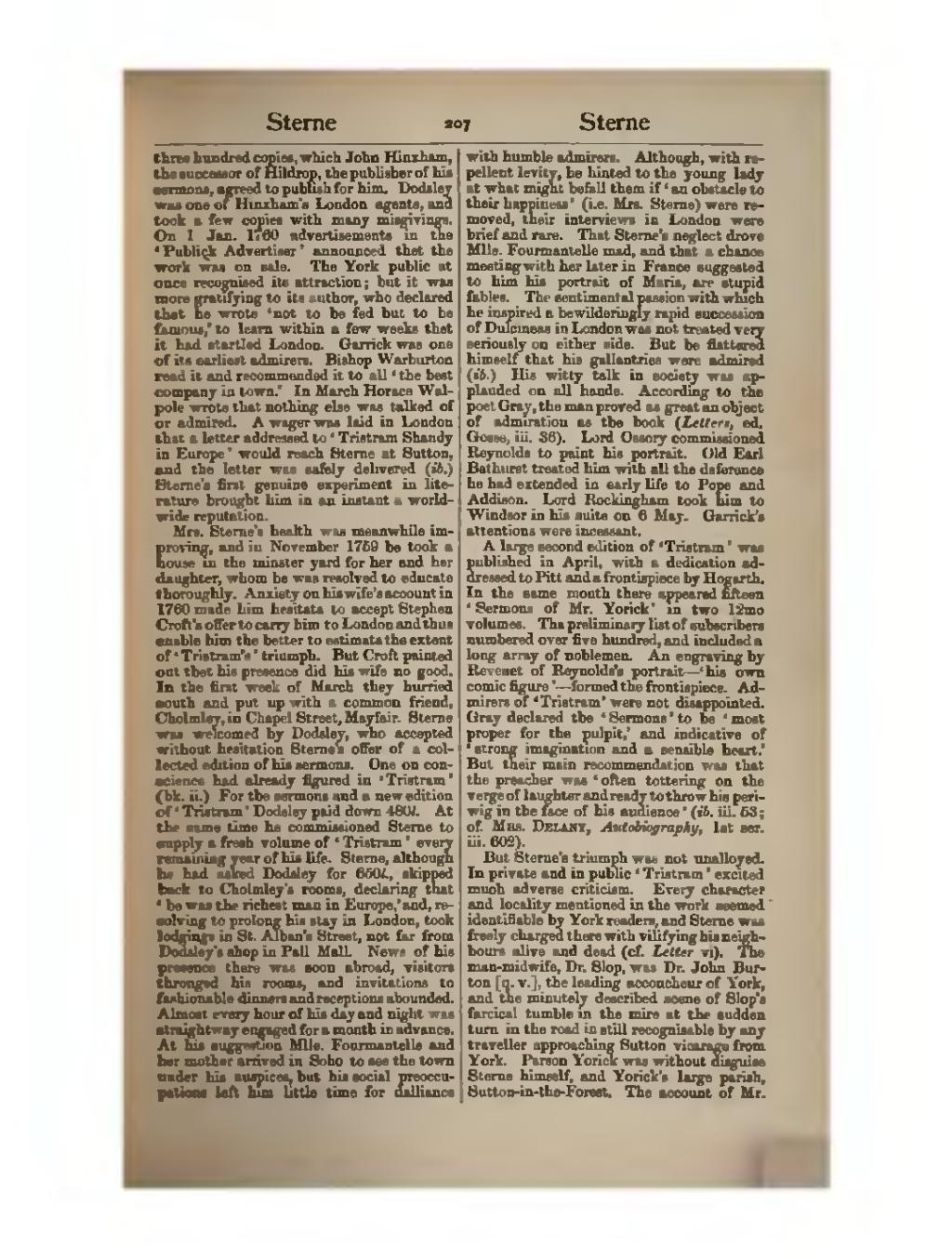three hundred copies, which John Hinxham, the successor of Hildrop, the publisher of his sermons, agreed to publish for him. Dodsley was one of Hinxham's London agents, and took a few copies with many misgivings. On 1 Jan. 1760 advertisements in the ‘Publick Advertiser’ announced that the work was on sale. The York public at once recognised its attraction; but it was more gratifying to its author, who declared that he wrote ‘not to be fed but to be famous,’ to learn within a few weeks that it had startled London. Garrick was one of its earliest admirers. Bishop Warburton read it and recommended it to all ‘the best company in town.’ In March Horace Walpole wrote that nothing else was talked of or admired. A wager was laid in London that a letter addressed to ‘Tristram Shandy in Europe’ would reach Sterne at Sutton, and the letter was safely delivered (ib.) Sterne's first genuine experiment in literature brought him in an instant a world-wide reputation.
Mrs. Sterne's health was meanwhile improving, and in November 1759 he took a house in the minster yard for her and her daughter, whom he was resolved to educate thoroughly. Anxiety on his wife's account in 1760 made him hesitate to accept Stephen Croft's offer to carry him to London and thus enable him the better to estimate the extent of ‘Tristram's’ triumph. But Croft pointed out that his presence did his wife no good. In the first week of March they hurried south and put up with a common friend, Cholmley, in Chapel Street, Mayfair. Sterne was welcomed by Dodsley, who accepted without hesitation Sterne's offer of a collected edition of his sermons. One on conscience had already figured in ‘Tristram’ (bk. ii.). For the sermons and a new edition of ‘Tristram’ Dodsley paid down 480l. At the same time he commissioned Sterne to supply a fresh volume of ‘Tristram’ every remaining year of his life. Sterne, although he had asked Dodsley for 650l., skipped back to Cholmley's rooms, declaring that ‘he was the richest man in Europe,’ and, resolving to prolong his stay in London, took lodgings in St. Alban's Street, not far from Dodsley's shop in Pall Mall. News of his presence there was soon abroad, visitors thronged his rooms, and invitations to fashionable dinners and receptions abounded. Almost every hour of his day and night was straightway engaged for a month in advance. At his suggestion Mlle. Fourmantelle and her mother arrived in Soho to see the town under his auspices, but his social preoccupations left him little time for dalliance with humble admirers. Although, with repellent levity, he hinted to the young lady at what might befall them if ‘an obstacle to their happiness’ (i.e. Mrs. Sterne) were removed, their interviews in London were brief and rare. That Sterne's neglect drove Mlle. Fourmantelle mad, and that a chance meeting with her later in France suggested to him his portrait of Maria, are stupid fables. The sentimental passion with which he inspired a bewilderingly rapid succession of Dulcineas in London was not treated very seriously on either side. But he flattered himself that his gallantries were admired (ib.) His witty talk in society was applauded on all hands. According to the poet Gray, the man proved as great an object of admiration as the book (Letters, ed. Gosse, iii. 36). Lord Ossory commissioned Reynolds to paint his portrait. Old Earl Bathurst treated him with all the deference he had extended in early life to Pope and Addison. Lord Rockingham took him to Windsor in his suite on 6 May. Garrick's attentions were incessant.
A large second edition of ‘Tristram’ was published in April, with a dedication addressed to Pitt and a frontispiece by Hogarth. On 22 May following there appeared fifteen ‘Sermons of Mr. Yorick’ in two 12mo volumes. The preliminary list of subscribers numbered over five hundred, and included a long array of noblemen. An engraving by Ravenet of Reynolds's portrait—‘his own comic figure’—formed the frontispiece. Admirers of ‘Tristram’ were not disappointed. Gray declared the ‘Sermons’ to be ‘most proper for the pulpit,’ and indicative of ‘strong imagination and a sensible heart.’ But their main recommendation was that the preacher was ‘often tottering on the verge of laughter and ready to throw his periwig in the face of his audience’ (ib. iii. 53; cf. Mrs. Delany, Autobiography, 1st ser. iii. 602).
But Sterne's triumph was not unalloyed. In private and in public ‘Tristram’ excited much adverse criticism. Every character and locality mentioned in the work seemed identifiable by York readers, and Sterne was freely charged there with vilifying his neighbours alive and dead (cf. Letter vi). The man-midwife, Dr. Slop, was Dr. John Burton [q. v.], the leading accoucheur of York, and the minutely described scene of Slop's farcical tumble in the mire at the sudden turn in the road is still recognisable by any traveller approaching Sutton vicarage from York. Parson Yorick was without disguise Sterne himself, and Yorick's large parish, Sutton-in-the-Forest. The account of Mr.
